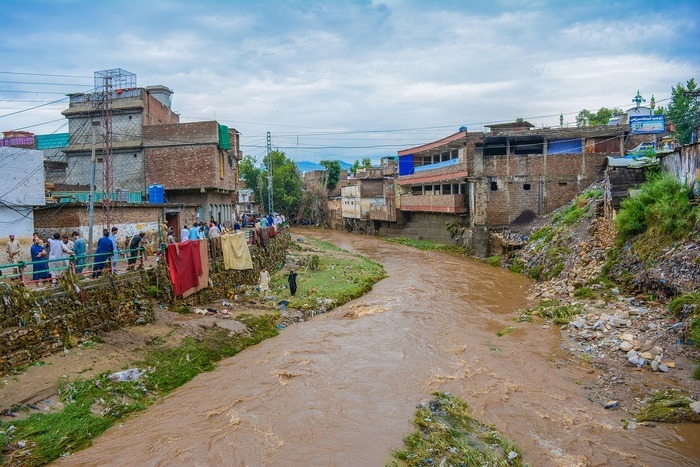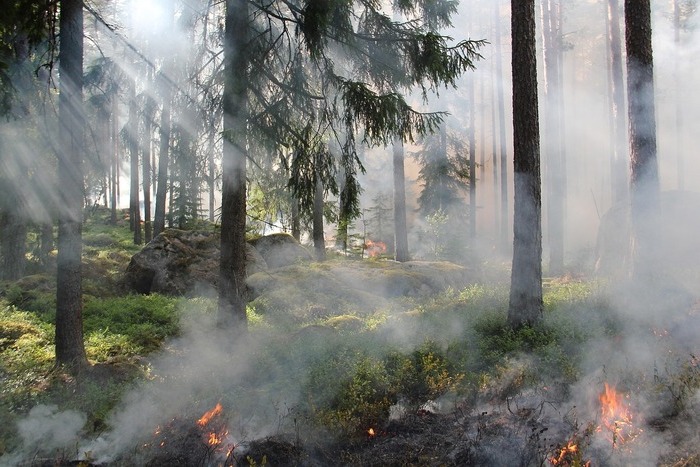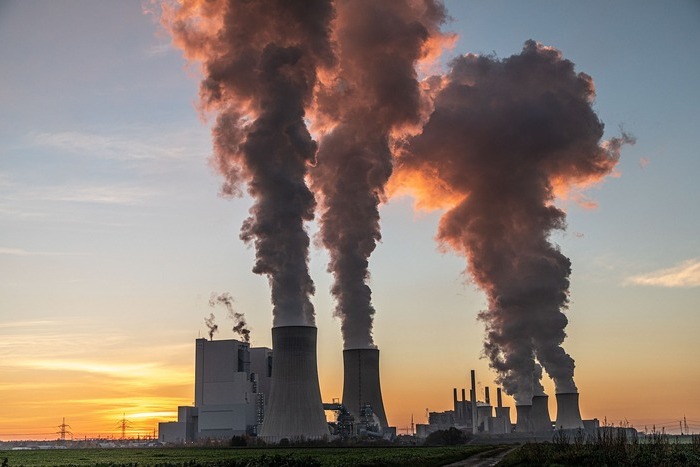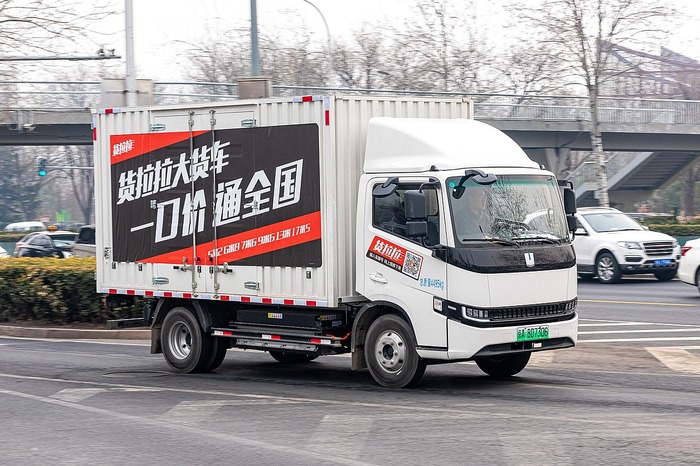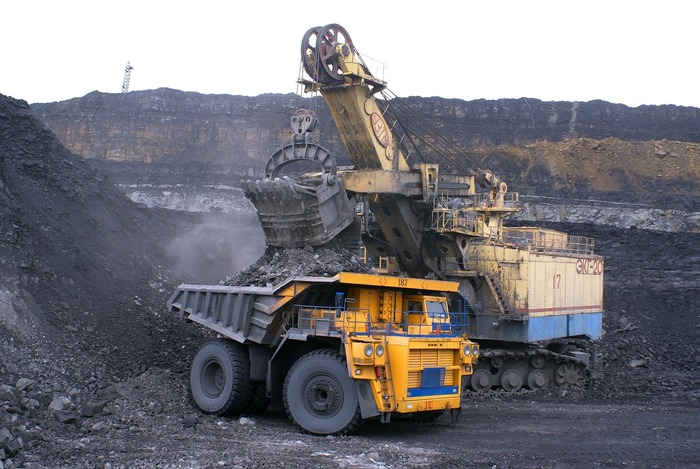
The country’s oldest textile traditions are under strain—and the artisans behind them are paying the price. Visual: Riddhi Tandon
Greener Textiles, Shrinking Margins: What the Sustainability Push Means for India’s Artisans
With CETP delays, water pollution crackdowns, and limited state support, the country’s oldest textile traditions are under strain—and the artisans behind them are paying the price
In the narrow lanes of Sanganer in Rajasthan, which is known for its centuries-old tradition of block printing, lie a myriad of tiny shops filled with vibrant and colourful clothes and busy block-printing units. Behind these shops lies a larger truth – a number of people working tirelessly in dingy spaces to bring these prints to life. But things were not always this busy. Around 20 years ago, many of these units were forced to shut down after synthetic dyes were found to be polluting local waterbodies and affecting livestock. The shutdowns hit the local Chhipa community—practitioners of the craft for over 500 years—particularly hard.
In a state like Rajasthan, where water is scarce and groundwater accounts for just 1.72% of the national stock, the block-printing industry’s water use in the state—up to 1,000 litres per unit per day, according to the Central Ground Water Board (CGWB) report —is no small issue. Using this figure, the scale of this consumption is staggering. With an estimated 850 dyeing and printing units in Sanganer, the textile industry consumes approximately 25.5 crore litres of water annually if they operate roughly for 300 days a year. According to the Ministry of Jal Shakti, the benchmark for urban water supply is 135 litre per capita per day (lpcd). This means that water consumed by just one printing unit in a year could meet the needs of approximately 1,293 households. Sanganer’s story mirrors wider concerns across India’s textile belts, where the push for sustainability is now closely woven to the question of survival—for both its workers and the environment.
India’s textile industry represents not just the country’s rich cultural legacy, it also serves as an economic lifeline. According to Invest India, the Indian textile and apparel industry is currently valued at approximately $174 billion and is expected to reach $350 billion by 2030. It is also one of the largest employers in the country, second only to farming, directly employing over 45 million people. The downside, however, is its footprint in the form of water use and pollution.
In June 2025, the Ministry of Textiles released a draft roadmap for 2047, which looks into building a sustainable, circular, and resource-efficient industry. This roadmap was announced after speaking to stakeholders, including the ministry’s ESG Task Force. Textile Secretary Neelam Shami Rao mentioned efforts taken in textile hubs like Surat, Tiruppur, and Panipat, ranging from wastewater recycling to renewable energy use and waste management that need to be scaled nationwide. A good start, but how this will be implemented across the country is still to be seen.
“The government needed to come up with a solution that not only looks at the environment, but also at the community relying on it,” says Vikram Joshi, who runs Rangotri Foundation, Rajasthan-based hand-block design studio.
The road ahead is riddled with tough questions. Who will bear the cost? Are traditional artisans getting the support they need to adapt? Can stringent green norms coexist with economic survival? And can India strive to make its textile industry more sustainable without leaving its workers behind? As CarbonCopy found while working on this report, the costs of sustainability are falling heaviest on the artisanal units in the textile supply chain.
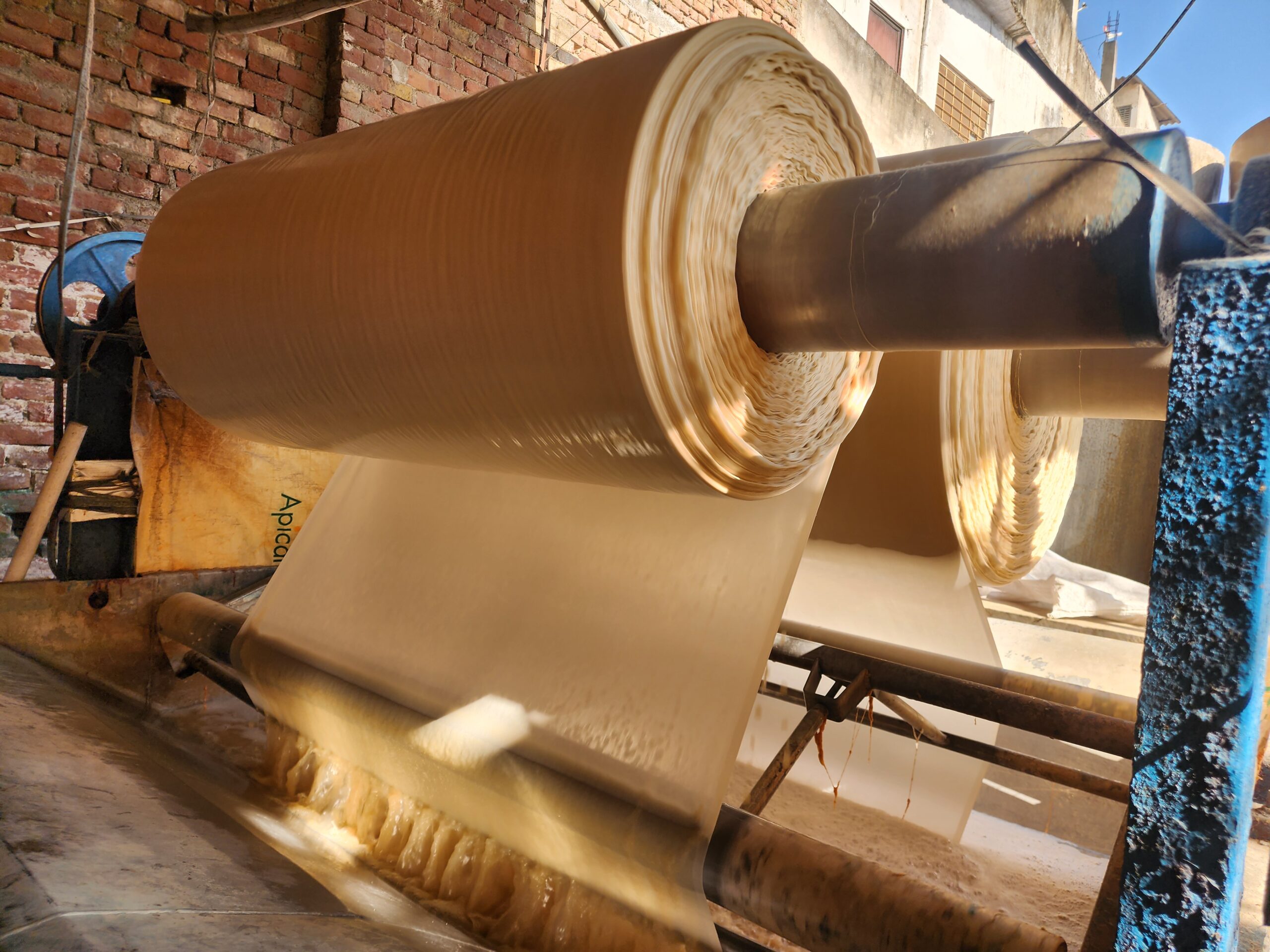
Before the dyeing process begins, the cloth is cleansed and treated. Photo: Paridhi Choudhary
The CETP Dilemma
In Sanganer, the area surrounding the Dravyavati river, extending for miles, is dominated by dyeing units. This river serves multiple purposes. It is used for harvesting water chestnuts, washing clothes, and providing drinking water for cattle. Yet, despite the vital role the river plays in sustaining livelihoods, it also bears the burden of untreated industrial waste.
Common Effluent Treatment Plant (CETP) facilities were set up in nearly every unit over two decades ago, but much of the wastewater still fails to reach the city’s lone treatment plant in the west. The infrastructure exists on paper — but not always in practice.
CETP plants were intended to treat and recover 80% of textile process wastewater, returning it to the system for reuse in dyeing, printing, and washing clothes. Furthermore, each unit is mandated to install individual effluent plants to maximise water recycling.
A nationwide report by the Central Pollution Control Board found that out of 191 CETP plants across India, only 128 were complying with norms, while 63 of them were non-compliant and another 84 units were under construction. A majority of these non-compliant CETP units are located in Gujarat, Rajasthan, Tamil Nadu, and Delhi.
Following the ban, dyers formed an association to collectively manage the costs of these CETP plants and navigate bureaucratic obstacles. Despite their efforts like providing a platform for the dyers to have a voice in the new regulations, challenges persist. Mohammad Salim, another dyer in the area, commented, “The government often cracks down on the dyers for the discharge of chemical water and this often affects our businesses.”
Salim explained that while their units treat wastewater, the primary challenge lies in the absence of a proper system to transport this water to the main treatment plant. He stated, “Currently, we are sending the water from our units in tankers, but this is not enough considering the amount of water used in processing the clothes, and the rest of the water ends up reaching the river.”
Baverwal says, “The main CETP unit that has been set up in the city can only accommodate wastewater from up to 400 units, but the total registered units in place are around 850.” He also mentioned that, due to the absence of a CETP, every dyer was required to pay ₹500 per month for the ETP set up in each unit.
Challenges for Salim and Baverwal still persist even after being registered as a part of the association of dyers in the area. They said that they paid a one-time fee of around ₹7.5 lakh. This fee has now gone up to ₹15 lakh. Many dyers in Sanganer can hardly afford this amount. Last year, a joint committee report on pollution of riverbodies in Rajasthan shut down 29 illegally operating textile units in the area.
In 2023, the National Green Tribunal (NGT) directed the state of Rajasthan to pay compensation of ₹100 crore for the damage to the environment caused by the textile printing unit in Jaipur. The bench at the time noted that the Dravyavati Restoration Project costing around ₹1,676.93 crore did not mention any formulation and execution of an action plan for the critically polluted area of Sanganer.
The green panel also gave liberty to recover this amount from units that have violated the norms. The bench also ordered that the CETP unit should be made operational, which has been in place since 2019. They also ruled that no new unit should open in the area till adequate infrastructure is in place.
But making CETPs work is easier said than done. A report by ScienceDirect highlighted the operational and technological challenges for CETPs across India, including outdated equipment, effluent quality, and lack of skilled labour. Without addressing these systemic issues, enforcement alone may not lead to meaningful clean-up, say experts.
“There is little left for us after paying rent and the fees for CETP,” says Hariom Baverwal, a dyer in Sanganer. Like him, many small-scale operators often bear the brunt of sustainability costs.
A shift to faster printing
The cost of compliance is not limited to dyers. Block printers and handloom workers, too, face rising costs, declining sales, and growing competition. Hand-block printing, an artisanal, time-consuming, and labour-intensive technique, faces competition from screen printing, an easier and more efficient method that gained popularity in the early 2000s, along with machine-made printing.
Competition from bigger brands has also forced the Chhipa community to take smaller orders and even shift to screen printing as the work remains labour-intensive and is set up in dingy places.
“I grew up learning the craft, but left it within a year and started working at a screen printing unit. Here the work is less labour-intensive than block printing and margins are much better.,” says Dinesh Marwal, one such artisan from Sanganer.
The numbers reflect the shift. Screen printing can produce up to 500 metres of printing cloth in a day, while block printing can only produce up to 100 metres. But the environmental cost is high. The green tribunal has repeatedly mentioned water discharges from screen printing in its orders, which are often dumped in pits and potholes outside these units. However, unlike dyeing units, screen printing units remain largely unregulated.
Adding to the pressure is the broader textile economy. Fast fashion brands and online sellers frequently release new designs and patterns, making it tough for traditional artisans to keep pace. With states like Maharashtra, Gujarat, and Tamil Nadu quickly becoming hubs for mass production of machine-made textiles, the ground is shifting fast.
A missing support system
Himanshi Singh, who is a founding member at Bare Craft Consulting, a Delhi-based platform to bridge the gap between rural artisans and global small-medium-sized enterprises (SMEs) across India, says, “Most of the artisans at small scale struggle because most of the regulatory changes are often made for large-scale industry, not handloom or cottage industries, creating confusion.”
Singh adds that unless artisans are financially and technically supported, imposing compliance can crush livelihoods, especially in rural places.
Rohit Rusia, founder of ASHA, an organisation working to revive handblock printing in Madhya Pradesh, said they have been working along with the women in Chhindwara district in the state, and they make water for pigment from vegetables. ASHA now sells their products across the country without any middlemen or brands to provide a minimum sustainable income starting from ₹12,000-₹13,000 per month to their artisans.
He says, “Unlike Rajasthan, we did not get any state support to revive the industry, and after the cancellation of contracts from Madhya Pradesh emporium, many artists here are struggling to sustain.”
Until recently, many artisans relied on government emporiums and Tribes India stores to sell their products under the Ministry of Welfare of India. However, these institutions are now plagued with challenges such as delayed payments and diminishing sales. The state emporiums have now stopped accepting their work, artisans say.
“Products that are available through government emporia [state or central] have deteriorated in quality and workmanship, because of both these issues, and because of a lack of a skill and quality mindset within the government framework. All of these mean that the multi-generational chain of craft and skill gets broken due to unfavourable economic and regulatory conditions,” says Devangshu Dutta, founder, Third Eyesight.
This erosion is playing out on the ground in Sanganer. Most artisans here said the profit margins have reduced over the years and the clientele is also dwindling.
While the lack of institutional support continues to undermine artisans across regions, those trying to stick to sustainable practices like natural dyeing face an additional layer of financial and operational hardship.

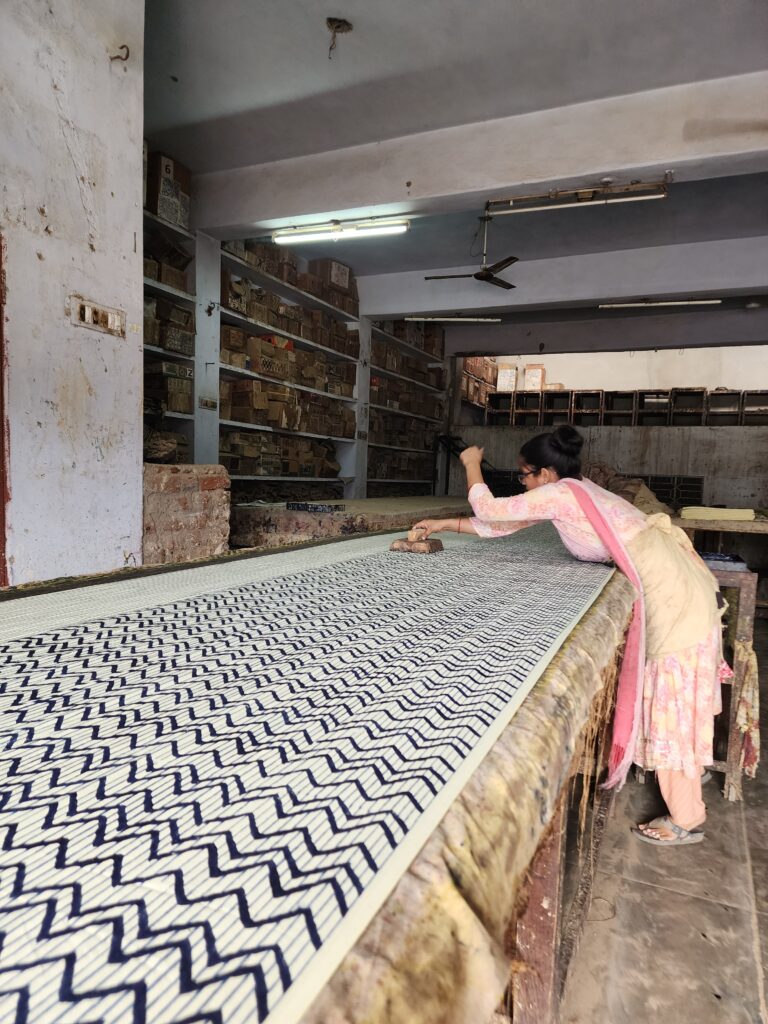
The Cost and Complexity of Sustainable Dyeing
Bagru, a village 30 kms south of Sanganer, houses some of the few block printing units that still work with natural dyes. These dyes are environmentally friendly because water discharged from them can be reused directly for farming and feeding livestock without the need for effluent treatment. One such artisan is Sunil Narain Titanwala. He shifted to Bagru from Sanganer about 40 years ago and started his unit here in the village. Unlike his counterparts in Sanganer, he continued to use vegetable dyes for dyeing and block printing.
He has worked with many brands in India and abroad, including Anokhi, with whom he has had a working relationship for more than two decades. He says that even though there are many opportunities coming his way, he struggles to keep up because of a persistent labour shortage in his unit. “I don’t have enough money to hire more labour because at the end of the month, I am left with ₹20,000-30,000 in hand. I have to also look at the household expenses and water and electricity bills in that money.”
He says many workers from the Chhipa community, who once ran traditional craft shops in the village, have now turned to selling machine-made clothing.
Prahlad Dosaya, another natural dyer in the village Dosaya has also been working with Anokhi and has about 130 people working with him.
Shubham Dosaya, Dosaya’s 21-year-old grandson, who manages the unit along with his grandfather, says, “We have a lot of demand coming our way, but the major problem we face is time constraints. We cannot work during the monsoon season because we cannot dry the dyed clothes outside.”
He adds that the hand-block industry, especially when relying on natural dyes, is not profitable. The price of their work is dependent on the kind of designs they are making. He says, “For every metre of cloth we sell, we earn ₹150, and the profit margin is around ₹6.”



Before and After: The design undergoes a month-long process before it can be transformed into reality through natural dyeing. Photos: Paridhi Choudhary.
Brands and margins
Anokhi, which was founded by John and Faith Singh in 1970, committed to provide sustained work to artisans throughout the year. It has 25 shops across India and 8 international stores, which sell products ranging from clothing to furnishings.
On the use of natural dyes and sustainability, Singh says, “We collect and recycle water. This does not supply all of our water needs, but we are able to collect a substantial amount of rainwater across several very large reservoirs, which replenish throughout the monsoon and last for several months after. We recycle our printing effluent and are able to reuse that for the staff bathroom in the factory, amongst other things.” She adds, “Our natural dye percentage is almost 20% in our shops, and we are continuously trying to increase the percentage for natural dye.”
“We create items [clothes] where we can remain price-sensitive and make a decent margin”, says Rachel Singh, Director, Anokhi. “ Those items support other products we create where we continue to be price-sensitive, but can only make very little margin because the costs are greater. “ The year-on-year revenue of Anokhi for fiscal 2024 was ₹153 crore as per their MCA filings under the name of Gangaur Exports Private Limited.
There are also many export houses on the outskirts of Jaipur, which source from a cluster of producers. They are all situated in a new industrial area created called Jaipur Integrated Textcraft Park. They have an in-house effluent treatment plant and rainwater harvesting. Joshi from Rangotri Foundation says, “Although we still use synthetic dye for printing, we have set up an in-house treatment plant for sustainability.” He said that their annual turnover comes to around ₹12 crore.
But the margins tell a different story when viewed from the artisan’s end. For example, a kurta at a high-end sustainable label with an indigo block print design costs around ₹3,550. The cloth length of this kurta is 85cm. A natural dyer that CarbonCopy met said they would sell the same cloth for ₹375 per metre.
On top of this, many brands have patented every design, leaving artisans with no rights over them. They send artisans designs they want them to create, and sharing or mimicking these designs could cost them their wages.
Questions around authenticity remain. “True supply chain transparency is followed by very few brands. Large brands can and do get away with greenwashing on a global scale, not just in India – by certifying a very small fraction of their product as water-friendly or carbon-friendly, large brands that are otherwise pushing disposable fashion get to pretend that they are green,” says Dutta.
A report by Access Development Service, which works on sustainable development goals through grassroots partnerships, highlighted that the handloom sector continues to face myriad challenges like weak implementation of protective regulation, limited consumer awareness about India’s diverse textile traditions and the undervaluation of handloom products.
The road ahead
For artisans like Titanwala and Dosaya, demand for natural-dyed clothing is rising, but so are the barriers to scale. Without financial backing, even sustainable production becomes unsustainable.
As Himanshi Singh pointed out, big brands have the resources to shape the sustainability narrative. But for small-scale artisans, especially in rural India, sustainability isn’t a buzzword, it’s a daily calculation of how to preserve tradition, protect the environment, and still make a living.
To truly save the traditional handloom industry, promotion of natural dyes must be scaled up with modernisation of CETPs, stricter environmental monitoring, and financial aid for small dyeing units, especially in handloom-rich areas, says Himanshi Singh. A cluster-based community led model, backed by government subsidies, private partnerships, and green technology is the way ahead to preserve the craft.
The handloom industry remains the second-largest employer in rural India after agriculture. Without fair pricing, adequate infrastructure, and targeted policies, this thread of India’s cultural and economic fabric risks being slowly unspooled.
78 dead in Himachal flash floods. Photo: Pixabay
78 Dead In Himachal Flash Floods, 4 Uttarakhand Districts On Landslide Alert
According to the state disaster management authority (SDMA), Himachal Pradesh reported 23 flash floods, followed by 19 cloud burst incidents and 16 landslides early July. This changed the face of the state for the worse, with the death count rising to 78 since the onset of the monsoon on June 20.
At least 37 people are still missing and 115 have been injured. The state has suffered widespread infrastructural damage, reported NDTV. In the worst-hit Mandi district, the first floor of the Himachal Cooperative Bank was filled with water and debris. This was the only bank for a town with a population of 8,000, the outlet said.
The report added that the Geological Survey of India issued a landslide warning for four districts in Uttarakhand — Tehri, Uttarkashi, Rudraprayag, and Chamoli. The alert warned of potential landslides on July 7 and 8 in several subdivisions, including Chamoli, Ukhimath, Ghansali, Narendra Nagar, Dhanaulti, Dunda, and Chinyalisaur
At least 161 people missing in Texas floods as death toll rises to 109
At least 161 people are still missing after devastating floods in Texas, “raising the possibility that the death toll could surpass 200 in what is already one of the deadliest flood events in the past five decades”, the Washington Post reported, adding that 109 people are confirmed to be dead, including “more than two dozen children”.
Euronews reported that a slow-moving storm brought heavy rainfall overwhelming riverbanks and inundating small towns with water that rose faster than many could escape. Officials referred to the event as a ‘100-year flood”, however, meteorologists said the scale of this week’s rainfall was anything but typical. “The combination of near-record water temperatures in the Gulf of Mexico, remnants of Tropical Storm Barry and the lack of a jet stream to blow it away funnelled extreme moisture into Texas. In retrospect, a warning sign that the floods could be historic,” the outlet reported.
A drought in Kerrville, Texas, contributed to the deadly floods that swept through the region, as dry soils were unable to absorb water when it fell as rain, Bloomberg reported.
“The surrounding county was 100% in drought at the start of July. Ironically, that drought helped beget the deadly floods that swept through the region on Friday.”
Guardian reported that Texas senator Ted Cruz has “ensured a reduction in funding to the National Oceanic and Atmospheric Administration’s (NOAA) efforts to improve future weather forecasting of events that cause the sort of extreme floods that are being worsened by the human-caused climate crisis”. It added: “A further $50m in NOAA grants to study climate-related impacts on oceans, weather systems and coastal ecosystems was also removed.” Trump has “cautioned against casting blame” for the flooding, reported New York Times.
EU countries seek more cuts to deforestation rules, letter shows
From December, the deforestation law, a world first, will require operators placing goods including soy, beef and palm oil onto the EU market, to provide proof their products did not cause deforestation, reported Reuters. Brussels has already delayed its launch by a year and cut back reporting rules following criticism from trading partners, including the US, as well as from EU countries, the outlet said. The newswire reported that the letter calls for the EU rules to exclude imports from countries at “low risk” of deforestation.
According to Bloomberg, “instead of targeting deforestation where the risk is highest, the regulation imposes disproportionate bureaucratic obligations on countries, where deforestation is demonstrably insignificant.”
June was 3rd-warmest globally: Copernicus Climate Change Service
June was the third-warmest globally, with an average surface air temperature of 16.46°C, around 1.30°C above pre-industrial levels, according to a Copernicus Climate Change Service (C3S) analysis, reported HT. The 12-month period between July 2024 and June 2025 was 1.55°C above the pre-industrial level.
The analysis revealed that most of Western and Central Europe experienced warmer than average air temperatures in June 2025. Western Europe experienced its warmest June on record. Temperatures were mostly below average in southern South America. There were record cold conditions in Argentina and Chile. India experienced below-average temperatures.
Despite farmers adapting to climate change, yield losses, especially in India’s wheat growing regions, to be severe: Study
Wheat crops will experience some of the most severe losses as maximum and minimum temperatures rise, reported DTE. Under a high-emissions scenario, the scientists estimated yield losses of 40-100% in northern and central India, 30 to 40% in China, Russia, the United States and Canada and 15 to 25% in Eastern Europe, Western Europe, Africa, and South America.
Stabilised global warming will still leave 39% of glaciers lost
If global warming remained at current levels — 1.2°C above pre-industrial levels — the world would still lose 39% of its glaciers compared to 2020, leading to 113 mm sea-level rise, a new study with a novel approach to data found, reported Mongabay . “This substantial present-day committed mass loss highlights that today’s glaciers are strongly out of balance with current climatic conditions due to their long response times,” the study said.
The outlet pointed out that meeting the limits of the Paris Agreement (limiting warming up to 1.5 and 2°C) could mean committing to 47% and 63% of glacier mass loss relative to 2020 levels. The findings — three times larger than most other projections — is the result of an approach using eight glacier models across 80 climate scenarios.
Declining winter snowpack offsets carbon storage enhancement from growing season warming in northern temperate forest ecosystems
A decline in winter snowpack partially offsets the boost to carbon storage from growing season warming in northern temperate forests, according to a 10-year experiment, reported Pnas. . The results come from the decade-long “climate change across seasons experiment”, conducted at the Hubbard Brook experimental forest in New Hampshire, US. The authors explained: “Past studies show that growing season warming increases forest carbon storage through greater soil nutrient availability that contributes to greater rates of net photosynthesis, while reduced winter snowpack induces soil freeze/thaw cycles that reduce tree root vitality, nutrient uptake, and forest carbon storage…We found after a decade of treatments that growing season warming increases cumulative tree stem biomass carbon by 63%. However, winter soil freeze/thaw cycles offset half of this growing season warming effect.” The results suggest “current Earth system models are likely to overestimate the carbon sink capacity of northern temperate forests”, the authors added.
Damage to Natural Forest. Photo: Pixabay
Affidavits in SC flag ‘two-fold’ damage to natural forests
Affidavits filed in the Supreme Court flagged concerns over a two-fold destruction of the country’s natural forests if forest lands are used for compensatory afforestation as prescribed by the Forest (Conservation) Amendment Rules 2023, HT reported. Experts and former forest officials filed a status report after the top court on February 3 directed that the government refrain from taking steps that lead to reduction of forests “unless compensatory land is provided” for afforestation,” the newspaper reported.
“The analysis of the minutes of the FAC meeting clearly show that degraded notified forest lands and unclassed forest lands are continued to be offered for compensatory afforestation,” the petitioners said.
The petitioners were referring to the minutes of FAC meetings held after the February 3 order, which showed that 603.8314 ha of forest land was approved for diversion, of which 140.7977 ha is in unclassed forests and 2.2567 ha in degraded forests, the outlet explained. The Supreme Court is scheduled to hear the petition against the validity of the Forest (Conservation) Amendment Act 2023 once the courts reopen after summer vacation.
Govt notifies draft carbon rules for industries
The Centre released emission targets for 2025-26 and 2026-27 for a range of industries under the carbon trading market and suggested that the carbon market will become operational during the period, reported HT. The targets have been issued for three companies in aluminium; 253 in the iron and steel sector; 21 in petroleum refining; 11 in petrochemicals; 11 naphtha ; and 173 spinning/textile units which have registered under the scheme.
The draft notification also stated that the obligated entity (company) shall achieve the GEI targets in the respective compliance year as per the schedule provided in the draft notification, the newspaper noted. They can meet their GEI target for the respective compliance year by purchasing carbon credits certificates from the Indian carbon market, in case they do not achieve the prescribed GEI target, the outlet said. The GEI targets will be calculated by the Bureau of Energy Efficiency (BEE).
Nine projects in India produced ‘problematic’ carbon credits in 2024, says report
An analysis of the global voluntary carbon market found that millions of carbon credits retired in 2024 were unlikely to result in additional emissions reductions, Mongabay reported. Nine out of the 47 largest projects that produced “problematic credits” were located in India, the report, released by the civil society organisation Corporate Accountability, found.
Citing the report, the outlet reported that over 47.7 million carbon credits in 2024 were “problematic,” meaning they are unlikely to deliver real emission reductions. The outlet noted that many of these projects were found to lack additionality — particularly large-scale solar, wind, and hydropower projects that would have happened anyway due to policy incentives.
Nine renewable energy projects from India feature in the report’s list.
No independent member in key environment panel: Experts
The Constitutional Conduct Group—a panel of former civil servants set up following Supreme Court orders—has written to the court raising concerns that the Central Empowered Committee on environmental matters is functioning without any independent members.
Citing the panel, HT reported that the outcome of a petition on the Forest Conservation Amendment Act 2023 “may possibly be compromised considering the conflict of interest” of the CEC. The panel claimed this in a letter to the Chief Justice of the Supreme Court of India. “In 2023, since Ministry of Environment, Forests and Climate Change (MoEFCC) seemingly had complete autonomy in choosing the members of the CEC, it nominated in all the four posts of members, four former government officers, three of whom are retired Indian Forest Service officers and one, a retired scientist, who had also worked for many years until his retirement in the MoEFCC. There are no independent experts.”
Forest advisory committee: Take steps to fast-track, streamline forest clearances
To fast-track clearances, the forest advisory committee (FAC) recommended dropping multiple enquiries for essential details, not insisting on hard copies of project details, and reviewing pendency of forest clearance applications every fortnight, HT reported.
Forest and environmental clearance are mandatory for any major industry or infrastructure project that is coming up in or near forest land. FAC, a statutory body under the ministry of environment, forest and climate change (MoEFCC) has also decided that some proposals need not be referred to it or regional empowered committees (RECs). These include proposals involving: a change in the name of the user due to inheritance by legal heir; change in name of company, etc; transfer of approval from one user to another such as transfer of mining leases; change in some of the patches of compensatory afforestation (CA) sites due to unforeseen reasons; delay in submission of compliance of in-principle approval conditions after the stipulated period when this is done with valid and cogent reasons for the delay, the outlet noted.
FAC stressed that the authorities, while processing proposals, need to adhere to the timelines as provided in the Van (Sanrakshan Evam Samvardhan) Rules, 2023. The nodal officer, along with the concerned divisional forest officers in the state/UTs may review the pendency of proposals on a fortnightly basis to process and dispose of the case within the prescribed time lines, it said.
SO2 emissions from coal plant. Photo: Pixabay
Centre eases SO2 emission norms, exempts large number of coal plants
The environment ministry again extended the SO2 compliance deadline for coal-based power plants located within 10 km of the National Capital Region or cities with over one million population from December 2024 to December 2027, ET reported.
Plants in critically polluted or non-attainment areas will now be assessed on a case-by-case basis, while those located elsewhere have been fully exempted, provided they meet stack height criteria. Of around 600 thermal power units in India, 462 are Category C units and 72 are Category B units.
Studies by institutions such as NEERI, NIAS and IIT Delhi were being “selectively used to justify inaction” by power plants across the country, which continue to delay the installation of flue gas desulphurisation (FGD) units to control SO2 emissions, PTI reported.
India established stringent sulphur dioxide emission standards for coal-based power plants in December 2015, requiring compliance within two years. Even after multiple extensions, 92% of coal-fired power plants have not yet installed flue gas desulphurization units to control SO2 emissions, a major air pollutant that converts into fine particulate matter (PM2.5) and causes a range of diseases.
NGT notice to Centre and Gujarat pollution board on issue of disappearing lakes
The National Green Tribunal (NGT) issued notices to the Central Pollution Control Board (CPCB), the Gujarat Pollution Control Board (GPCB) and the District Magistrate of Ahmedabad over the issue of disappearance of lakes flagged by Ahmedabad Municipal Corporation (AMC), IE reported.
The court registered a suo motu case on the basis of The Indian Express report that cited Ahmedabad Municipal Corporation stating that 37 of 172 water bodies in the city have vanished. According to the report, these water bodies vanished primarily because they were not recognised in the statutory development plan, which allowed for their encroachment and conversion.
CPCB report confirms illegal mining around Ganga river in Dehradun
A Central Pollution Control Board (CPCB) report to Uttarakhand High Court confirmed the prevalence of illegal mining around the Ganga river (from Raiwala to Bhogpur in Dehradun), reported DTE. NGO Matri Sadana alerted the court with photographic evidence and eyewitness testimonies of indiscriminate mechanised mining. The inspection report found mining activities at only 501 m and 802 m from the Ganga. The Consent To Operate certificate expired in March 2022, and the mines lacked proper green belts and dust control measures.
In some areas where the Ganga meets its tributary Ravasan, the report found mines to depths up to 2.2 m, exceeding the permissible limit of 1.5 m.
The petitioners said CPCB report did not include comparative data or analysis showing the extent of environmental damage from illegal mining or the impact on local communities, including the devastation of farmland which was visible in satellite images. Matri Sadan has now requested a reinspection under direct supervision of the court.
Industrial pollution: Green court serves notice to Haraya and central pollution control bodies
Two years after a petition raised alarm over 21 industrial units operating in the region, the National Green Tribunal (NGT) issued notices over alleged regulatory lapses and categorisation concerns in Panipat’s Madlauda industrial area, TOI reported.
The notices follow a petition by a resident of Sutana village in Panipat. The pollution boards have been asked to submit relevant documents and take appropriate steps. The matter is listed for hearing on October 15. The NGTl issued notices to to Haryana State Pollution Control Board (HSPCB) and Central Pollution Control Board (CPCB) over the issue of industrial units — involved in the manufacture of textiles, chemicals, pesticides and cement — engaged in hazardous activities without sufficient regulatory oversight or pollution control compliance.
Elon Musk’s xAI get green signal to instal polluting methane gas generators near black neighborhoods
Elon Musk’s artificial intelligence company xAI was granted a permit to run methane gas generators at its massive datacenter in Memphis, Tennessee, from the county health department. This has sparked outcry from the local community and environmental leaders, who said the generators pollute their neighborhoods, the Guardian reported.
Musk’s xAI set up its massive datacenter in Memphis roughly a year ago. To supplement the facility’s heavy power usage, the company brought in dozens of portable methane gas generators. xAI did not have a permit for the generators, but seemed to have found a loophole in the system that allowed it to use the turbines as long as they were not in the same location for more than 364 days, the newspaper reported.
The pollution’s proximity to Black neighborhoods has caught the attention of the NAACP civil rights group. It has initiated a lawsuit against xAI alleging the company is violating the Clean Air Act by illegally installing and operating the methane gas generators.
Photo: Pixabay
India meets 50% of its installed electricity capacity from non-fossil fuel sources five years early
India has hit a target for 50% of its installed electricity generating capacity to come from non-fossil fuel sources five years early, reported Reuters. The news wire said the announcement follows India’s renewable power output rising at its fastest pace since 2022 in the first half of 2025, while coal generation declined by nearly 3%. Fossil fuels still constitute over two-thirds of the increase in generation last year and India is planning to expand its coal-fired capacity by 80 gigawatts (GW) by 2032 to meet rising electricity demand, the outlet added. The report pointed out that India missed its 2022 renewable target of 175GW but has since “ramped up solar and wind additions” towards a goal of 500GW of non-fossil capacity by 2032. Renewable energy minister Pralhad Joshi tweeted: “In a world seeking climate solutions, India is showing the way”, reported TOI.
India’s overall non-fossil capacity has reached 242.8GW, out of a total of 484.8GW, PTI reported.
IRENA: Global renewable power capacity surged by 15% in 2024
Global renewable power capacity grew by 15% last year, according to the latest annual statistical report from the International Renewable Energy Agency (IRENA), BusinessGreen reported. According to the outlet, this was “driven in large part by the rapid roll out of wind and solar projects across Asia, which have led to a widening of the gap between regions capitalising on the clean energy boom and those at risk of being left behind”. The report showed the world added 582 gigawatts (GW) of new renewable electricity capacity in 2024, representing a record annual increase, the outlet added.
India installed 341MWh battery storage capacity in 2024
India installed more than 34i MWh of battery energy storage systems (BESS) which is six times more than 51 MWh it had in 2023, Mercom reported. The total energy storage capacity is at 442MWh. Of this, only 4% is from stand-alone BESS, while 60% from solar plants integrated with battery storage and 36% from renewable energy integrated with round-the-clock capabilities.
US: Trump executive order seeks end to wind and solar energy subsidies
Donald Trump signed an executive order telling federal agencies to “strengthen provisions in the One Big Beautiful Bill Act that repeal or modify tax credits for solar and wind energy projects”, reported Reuters. In an executive order, Trump said the renewable energy resources were unreliable, expensive, displaced more dependable energy sources, were dependent on foreign-controlled supply chains and were harmful to the natural environment and electric grid.
The order directed the treasury department to enforce the phaseout of tax credits for wind and solar projects that were rolled back in the budget bill passed by Congress and signed into law by Trump last week. It also directed the Interior department to review and revise any policies that favour renewables over other energy sources. Both agencies are required to submit a report to the White House within 45 days detailing actions taken.”
Bloomberg reported that the order “also calls for the implementation of restrictions on incentives for clean-energy projects that have ties to foreign entities of concern, including China”.
Saudi Arabia signs 5 solar PPAs totaling 12 GW
Saudi Arabia signed five solar power purchase agreements (PPAs) for a total capacity of 12 GW. The PPAs were signed between the Saudi Power Procurement Company and a consortium led by ACWA Power acting as the main developer, in partnership with the Water and Electricity Holding Company (Badeel) and Aramco Power, reported PV Magazine.
The solar projects include the 3 GW Bisha project in the Aseer region at levelized cost of electricity at $0.0129/kWh. The five solar PPAs are rounded off by two 2 GW projects in the Riyadh region. A further two PPAs, covering two wind energy projects with a combined capacity of 3 GW, were also signed. The seven agreements represent the largest capacity globally signed for renewable energy projects in a single phase, the outlet reported.
Australia’s green hydrogen plan faces water shortage
Australia wants to be a massive hydrogen export industry under its National Hydrogen Strategy but no green hydrogen project has yet succeeded in Australia, reported PV magazine adding that water shortage is a major issue flying under the radar. Globally, just 7% of announced green hydrogen projects are up and running.
Hitting the 2050 target of 15 million to 30 million tonnes of hydrogen a year would use 7-15% of the amount of water Australia’s households, farms, mines and black coal power plants use annually. That’s simply not sustainable, the outlet said.
The government hasn’t properly accounted for the water cost for green hydrogen. For every kilogram of hydrogen produced through electrolysis, nine litres of water are directly consumed, the report said adding that “the water needed to make hydrogen has to be extremely pure. Salt water has to be desalinated, and even fresh water needs purification. Equipment also needs cooling, which consumes even more water.”
“All these processes incur substantial indirect water losses, such as the water used for industrial processes and cooling. The volumes used are highly uncertain. They can be up to 20 times greater than the direct water use,” PV magazine report said.
Photo: Wikimedia Commons
Rising sales of electric trucks lead to dip in diesel use in China
In China, the rise in electric truck sales have led to a slump in diesel use, reported Reuters. Electric and LNG-fuelled trucks comprise a fourth of all new truck sales in the first half of the year. Diesel consumption will most likely fall by 6.3% in 2025, according to a consultancy.
VinFast to expand to 27 Indian cities, signs deal with BatX Energies for battery recycling
VinFast, the Vietnamese electric car manufacturer, is expanding operations in India by signing pacts with 13 auto dealers across 27 cities. This can potentially lead to opening 35 VinFast showrooms, reported TOI. Parallely, VinFast has also entered into an agreement with Indian battery recycler BatX Energies. Through this agreement, BatX will handle recycling and repurposing of batteries for VinFast in India, as well material recovery and after-sales operations, reported ET.
Tesla opens first Indian showroom in Mumbai
Elon Musk-owned electric vehicle giant Tesla is finally entering the Indian market after years of talks and negotiations. On July 15, the American manufacturer will open its first showroom at Mumbai’s Jio World Drive at the Bandra Kurla Complex, reported Exchange4Media. The showroom will function as an experience showroom, as well as an outlet for service, sales and spares. Interestingly, Tesla is not manufacturing cars in India, but importing from the USA and China under a temporary tax concession window.
DRX cathode materials offer path to less pricey, cobalt-free cathodes for batteries
Researchers at McGill University have devised a novel way of manufacturing cathodes that don’t require expensive metals like cobalt and nickel, which are also ecologically destructive to source, reported Interesting Engineering. The researchers synthesised DRX cathode materials, which were earlier considered unstable, through a two-step molten salt synthesis, and produced a usable battery-grade cathode. During testing, the DRX materials-fitted batteries retained 85% of their capacity after 100 charge-discharge cycles — more than twice the durability of previously synthesised DRX particles.
Financial Industry Shifts from Coal Without Any Funding Cuts
Global financial industry’s vow to shift from coal has not translated into reduced funding as per new analysis from environmental groups, reported Axios. This analysis found that 650 commercial banks which provide finance for thermal coal production and coal fired power, showed $130billion in loans and underwriting in 2024.
This is similar to the $132billion in the year 2022 and an increase from $123billion in 2023. China has been the biggest source of finance from 2022 to 2024 with $248billion followed by the US, Japan, Europe, and Canada. A number of banks, including the big US banks are leaving various climate alliances except for the Citi Bank which has also increased its coal financing.
OPEC Cuts Oil Demand for Next Four Years on No Peak Demand in Sight
The OPEC group of oil-producing nations has cut its global oil demand forecasts for the next four years, as Chinese growth slows, Reuters reported. However, it also raised its longer-term forecast and said “there was no sign oil use had reached its peak”
The OPEC+ producer group, composed of OPEC plus allies including Russia, is also pumping more oil to regain market share to support the market after years of cuts.
India’s Import of Crude Oil From Russia Hits 11-Month High in June
India imported 2.08 million barrels per day in June from Russia, highest since July 2024 on the Israel-Iran War, reported ET Energyworld. While India’s global imports dropped 6% in June, Russian rose 8% month-on-month.
More than half of these imports from Russia were made by three Indian refineries, which also export refined products to G7+ countries.
China’s Coal Import Declines to a 2-Year Low in June
China’s coal imports declined to a two year low as miners speed up domestic production to replace lower grade coal imports, reported ET Energyworld. China’s June imports stood at 33.04 million tonnes, lowest since February 2023 and 26% down since June last year.
In the first half of the year, imports 11% year-on-year to 221.7 million tonnes. The import could also fall for a full year between 50 million and 100 million tons.
Trump’s Inaugural Fund Collected Over $19million From Fossil Fuel Industry
The fossil fuel industry donated over $19million to Trump’s inaugural fund, sparking concerns regarding the US President’s relationship with the oil industry, Guardian reported. This amounted to 8% of all donations it raised. The President raised $239 million for his inauguration which is more than the past three inaugural committees combined and double the previous record.
Chevron, the energy giant, made the largest contribution to the inaugural fund of $2 million, followed by ExxonMobil, ConocoPhillips, and Occidental Petroleum, among the fossil fuel giants.










